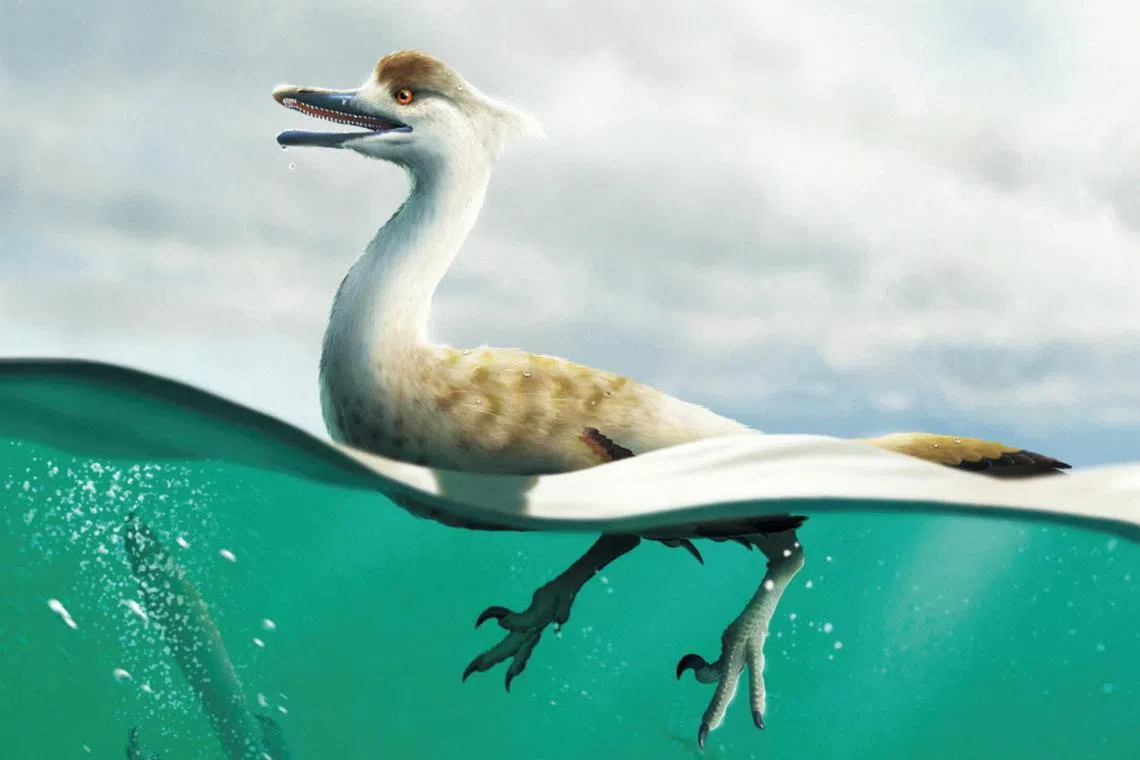‘Amazing’ goose-necked dinosaur was built like a diving bird
Sign up now: Get ST's newsletters delivered to your inbox

An artist's reconstruction of the bird-like Cretaceous period dinosaur Natovenator polydontus.
PHOTO: REUTERS
Follow topic:
WASHINGTON – The expansive dinosaur group that included big predators such as Tyrannosaurus rex was also populated by a number of oddballs, weirdos and outcasts. A newly described dinosaur from Mongolia – the size of a goose and looking a bit like one too – fits that description.
The dinosaur, called Natovenator polydontus, lived about 72 million years ago during the Cretaceous period and was built like a diving bird with a streamlined body. It possessed a goose-like elongated neck and a long flattened snout with a mouth bearing more than 100 small teeth, scientists said on Thursday. It almost surely was covered in feathers, they added.
“Natovenator has many peculiar characteristics,” said palaeontologist Yuong-Nam Lee of Seoul National University in South Korea, lead author of the research published in the journal Communications Biology.
While it was a cousin of speedy little predator Velociraptor, Natovenator was adapted to a semi-aquatic lifestyle in a freshwater ecosystem, perhaps floating on rivers and lakes, paddling with its front limbs, and using its flexible neck to catch fish and insects or diving underwater to capture its prey, the researchers said.
Its well-preserved remains – a skeleton about 70 per cent complete – were unearthed in the Gobi Desert, which over the decades has been a treasure trove for dinosaur fossils.
Natovenator is part of the dinosaur group called theropods – sharing traits including bipedalism – best known for large meat-eaters, including Tyrannosaurus, Tarbosaurus and Giganotosaurus.
But the theropods, many of which were feathered, branched out in unusual directions, with examples such as long-clawed ground sloth-like Therizinosaurus, ostrich-like Struthiomimus, termite-eating Mononykus and the entire bird lineage.
“The diversity of theropod dinosaurs by the end of the Cretaceous is totally amazing,” said University of Alberta palaeontologist and study co-author Philip Currie.
“I believe there will be more discoveries of fascinating, bizarre theropods in the future,” Professor Lee added.
‘Amazing little animal’
Not many of the dinosaurs called “non-avian” – in other words, not the birds – are known to have lived a semi-aquatic lifestyle. A close relative of Natovenator named Halszkaraptor, described in 2017, lived a similar lifestyle at roughly the same time in the same region. Both had a very bird-like appearance and were closely related to the bird lineage.
Natovenator measured about 45cm long, with a skull about 7cm long. Its front limbs appeared somewhat flattened, perhaps as an adaptation for paddling and swimming. The streamlining of its body is shown by ribs that point towards the tail, as in diving birds, an arrangement that reduces drag in the water and allows efficient swimming.
“Natovenator – which means ‘swimming thief’ – is an amazing little animal for several reasons. First, it is small and delicate. When we found it, we were uncertain as to its identification because it looked more like a lizard or mammal skeleton than a dinosaur. Once it was prepared, we realised it was a theropod dinosaur, but what kind? Finally, it made sense once Halszkaraptor was described,” Prof Currie said.
“It is very specialised for living in an environment not typical for an animal related to Velociraptor and its other relatives. Most people think of dinosaurs as specialised land animals, not competing with crocodiles in the water,” Prof Currie added.
There were various diving birds during the Cretaceous, including North America’s Hesperornis, which reached about 1.8m long, but none are known from the area Natovenator inhabited.
“More than 30 different lineages of tetrapods (terrestrial vertebrates) have independently invaded water ecosystems,” Prof Lee said. “Why not dinosaurs?“ REUTERS

